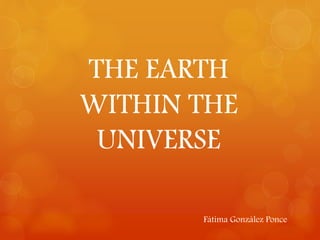
The earth within the universe
- 1. THE EARTH WITHIN THE UNIVERSE Fátima González Ponce
- 2. Theories about the Universe. • The geocentric theory: the Earth is in the centre of the Universe, and the Sun and the Moon turn around it. Mean scientist: Aristotle and Ptolomy. • The heliocentric theory: Sun is in the centre of the Universe, and the Earth revolves around it. Mean scientist: Copernicus, Galileo Galilei and Kepler. Nowadays, we know the Sun is in the centre of the Solar System, but it’s only one of the countless stars and systems in the Universe.
- 3. Galaxy contains: • Stars: large spheres of hydrogen and helium which release a great amount of energy from nuclear fusion. • Nebulae: large clouds of dust and gas. • Star clusters: related stars close to each other. Milky Way: Our galaxy is called the Milky Way. It has a nucleus of older stars, and a disk with arms, which contains younger stars. We are in the Orion Arm.
- 4. The Solar System The Solar System is composed of: • The Sun: a medium-sized star made up of 75% hydrogen and 25% helium. Its nucleus reaches at temperatures of 15.000.000 ºC. • Planets: the rocky planets (Mercury, Venus, Earth, Mars) and the Gas Giants (Jupiter, Saturn, Uranus, Neptune). • Dwarf planets: Pluto, Ceres and Eris. • Satellites • Comets: they are made up ice, rocks and dust. They can be short period comets (from Kuiper Belt) or long period comets (from Oort Cloud).
- 6. Features of the planets: • Revolution: orbit around the Sun. All of them have an orbit approximately in the same plane and in the same direction (anticlockwise). • Rotation: most of the planets rotate around an axis almost perpendicular, except Uranus (its axis is parallel to the revolution movement) and Venus (it rotates in clockwise direction).
- 7. The Planets (Rocky planets) Mercury Venus The Earth Mars Characteristic s Closest to the sun Craters Similar size and density to the Earth. Its rotation is in clockwise direction, the opposite than the other ones Optimal conditions for life to develop Liquid water Surface resembles Earth’s rocky deserts Atmosphere No Denser Composed of carbon dioxide and sulphuric acid Nitrogen and oxygen 95% of carbon dioxide Satellites No No The Moon Deimos and Phobos
- 8. The planets (Gas giants) Jupiter Saturn Uranus Neptune Characteristic s Rocky core Bands of different coloured clouds Ring system made of ice, dust and rocks Frozen planet Rotation perpendicular to the ecliptic Size similar to Uranus Frozen planet, but temperature inside very hot Composition Hydrogen and helium Hydrogen and helium Hydrogen, helium and methane Hydrogen, helium and methane Satellites Four large and smaller ones Seven large and more small ones Five large and more smaller ones The largest is Triton
- 9. The Earth-Moon System Revolution • Plane of ecliptic: is the plane of the planet’s revolution orbit around the Sun. • The Earth’s revolution takes 365’26 days. •Seasons are caused by the tilt of the Earth’s axis (23’5º). It produces a different angle in sunrays, changing the sunlight period and the temperatures depending on howperpendicular the rays are. Rotation • The Earth’s rotation takes 24 hours. • Its direction is anticlockwise (from west to east, therefore we see the Sun rising in the east and setting in the west).
- 10. The changes of the seasons are: • Vernal equinox (around 21 March): this day both hemisphere receives the same amount of sunlight, day and night have approximately the same length (12 hours) • Summer solstice (around 21 June): north hemisphere receives more sunlight and more hours of daylight. • Autumnal equinox (around 22 September): is exactly the opposite of spring equinox, but they have the same characteristics. • Winter solstice (around 22 December): northern hemisphere receives less light, daylight hours start to decrease, and winter begins.
- 12. The Moon We always see the same side of the Moon because its rotation takes the same time than its revolution. Due to the movement around the Earth, the Moon reflects the sunlight in its entire surface, or only in a part. These are the lunar phases: full moon, waxing moon, new moon and waning moon.
- 13. ACTIVITIES ACTIVITY 1 1. Working on a conceptual basis. (Each student must do a conceptual basis about the studied contents). ACTIVITY 2 1. Listen and say which theory the speaker is describing. What do we now know about where our planet is in the universe today? 2. Put the words in order to make questions. Listen and check. Then ask and answer the questions with a partner. do/contain/galaxies/What? does/a planet/ how long/ to revolve/ take/ around/ the sun/ once?
- 14. 3. Listen and repeat. Then write in the correct order, starting from the sun 4. Complete the text with the words. Listen and check Spring Autumn Summer Winter • _________this day both hemisphere receives the same amount of sunlight, day and night have approximately the same length (12 hours) • __________ north hemisphere receives more sunlight and more hours of daylight. • __________ is exactly the opposite of spring equinox, but they have the same characteristics. •___________ northern hemisphere receives less light, daylight hours start to decrease, and winter begins.
- 15. ACTIVITY 3 1. Ask and answer the questions with your group. • What types of movement do planets have? • What are comets made of? • What is the main gas the sun is composed of? 2. Describe a planet to your group. Guess what planet your partner is describing 3. Explain the following phenomena to your partners • We can’t see a new moon • Daytime and night-time